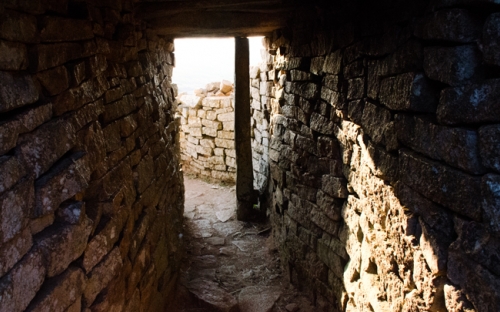Bringing Down the Walls
Since time itself, walls were built to protect societies and their livestock from conflict with wild animals, potential aggressors and the liberties taken by nature; sand or rain storms and other ruins-naturely. Walls evolved over time and we erected these to demarcate territory and assert claims to it. We housed ourselves, in the memory of our heroes we built walls and stamped their names on these or painted on them, poetry in their honour and for those unwanted elements, whether human or other forces, we built walls to shut them out or wall them in.
When in the embryonic days of city-states and heavy empires boundary walls were erected around cities, these were not mere freestanding perimeters but complex monolithic architectural structures purposed for martial strategy. They hosted surveillance towers and gates manned by guards who would open and close the gates at certain times of the day for inhabitants and visitors. Within the constructs of the walls and at intervals, were apparently, long and wide passages used for religious practice, commercial and other activity as far as the multiplicity of function afforded by cleverness of design went.
In Afrika’s Sub Sahara, the mortar-less walls of Great Zimbabwe testify to the masonry prowess of ancient Shona ancestors who harvested from the surface of the surrounding hills the granite stones that make up the wall. Here, and perhaps from an overly romanticized historical angle of Afrikans as benign and unbecoming of military strategy, freestanding walls are said to merely have enclosed a settlement. Retaining walls provided a barrier to the movement of earth, stone and water; bearing in mind that Great Zimbabwe is built near the southern edge of the plateau of Zimbabwean highlands. Great Zimbabwe, said to have been considered a rainmaking shrine, at a point was settlement to between 12 000 and 20 000 inhabitants depending on who tells the story.
Whether to protect us from the elements or from belligerents, these impregnable walls have for the most part served us well through time affording us the perception at least, of security. In time these walls have however also separated us, fast growing to suffocation magnitude in their closeness to us and for all our pursuit of freedom they have imprisoned us so that we expense to go out in the open and breath fresh air in the countryside, the seaside and any other land open for breathing air that is not
overly recycled.
The Great Enclosure at Great Zimbabwe (World Heritage Site)
Separation Barriers – Some Famous Walls
The Great Wall of China was built and maintained over centuries and dynasties to protect China from invasions from the north by Mongolian nomads; the high cost of its maintenance due to its enormity, often cause for much debate. Nonetheless rather than deter intruders, the wall strengthened the resolve of the nomads; escorted by hunger from the dry and barren lands in the north of China in pursuit of greener pastures, perhaps as well wanting to see what it was that China had that it felt it had to hide with hundreds of miles of wall that myth claims can be seen from the moon. China was on more than one occasion invaded, its rule overthrown despite the wall. On one such occasion China herself surrendered and opened the gates to be taken over. Over the years, possibly not seeing the value of the wall in the context of everyday survival, peasants living in its vicinity often raided the wall for its bricks to
build houses.
For 28 years the Berlin Wall, raised overnight, stood between East and West Berlin primarily to act as a barrier to the brain-drain that communist East-Germany experienced in the 50’s in the days when ‘moving on up’ was westerly and to keep the West and its ‘fascist’ opinion in the West. For the most part, the wall achieved its objective (albeit addressing only the symptoms of a problem), the exodus to West Germany only recommenced once the wall was collapsed. Years after the demolition of the wall, the people of Germany refer to it as ‘The Wall in the Head’ because its psychological effects can still be felt more than 20 years after the wall went down. The wall split families right in half and rendered many a worker in West Berlin residing in East Berlin jobless; as simple as people waking up and not being able to go to work the next day. People suffered mentally, social development suffered claustrophobia and the people of Germany still find it difficult to relate to one another even though the physical wall has fallen.
‘Privacy Walls’ - The not so famous walls
The less talked about walls in whose shadows lurks the daily negative news in which media swims, are the walls of our homes. When I was a child living with my parents in a house in a rural township of the then Bophuthatswana, garden-walled houses were a rarity; a sign of true prosperity. Like the other ten or twelve houses on my side of the street and opposite, wire mesh fencing which at one time stood shiny and taut in its glory, bordered our yard. Soon however, the shared fences between houses developed manmade holes big enough for an adult to pass through and over time some of the fences gave way and relaxed into the ground. You see, fences were more of a hindrance to our civic practices of visiting the neighbour just to chat, of going over to borrow salt because meat was on the stove and one had forgotten to buy some or simply had no money. For us children it did not make sense that you could see your neighbour’s house right through the fence, yet you had to walk all the way around through the gates to get there to play with your friends and often we would find ways sometimes landing us in trouble. But at least with this type of fencing, the illusion of space was there and you could still see a stranger walk up to your absent neighbour’s door.
In the more affluent suburbs private homes were surrounded not by mesh but by brick walls or more commonly ‘stop-nonsense’ (concrete precast) fencing so that one could see only the perfectly manicured gardens though holes in the pattern of the wall. It struck me then what a bother it must be for the children to have to walk all the way around to go play – if the gates were not locked. Perhaps these children did not visit as often as we did, I thought. High walls were so rare in my neighbourhood that I often overheard older people - whether influenced by envy or factual evidence - remark, “Iyo, she’s building a wall? They (criminals) are going to chop her up behind that wall and we won’t hear the screaming”.
But it was soon enough that most people in the race for upward social mobility gained pace and collected more personal luxury items and so mounds of soil and building sand piled outside people’s yards became a common sight so that our shoes were often filled with the sand that we notoriously mounted on our way back from school. Soon, walls were erected all around us at a fast and steady pace. A ‘decent’ wall surrounding one’s yard symbolized prosperity so that those households that struggled remained exposed, bare and shamed as if they were part of the street, as through them, we had shortcut access (double-ups) to everywhere. These houses lost their dignity later only recoverable by a wall.
Before the advent of these privacy high-walls, we shared what we had and cared what happened next door. By that I do not mean the breaking of bread or any other clichéd image of that kind of sharing, which as would be expected happened in any case; we shared resources, the children played on one grasspatch, one swing, it was easy enough to pool together chairs from the other households for an event at another. We could see in the streets when a particular child had bunked school or had no food. We could see the alcoholics and the mentally disturbed and we did something about it too.
The free for all movement between households that I experienced as a child ceased to exist so abruptly. No longer could we play freely in a communal backyard. Imaginably only in the more underprivileged residential spaces such as shanty towns and the rural areas do these living conditions still exist. These people perhaps still find a need to coexist and support each other. Here everyone knows the next person and his or her business, which despite the hype, is not altogether a bad thing. Here an old man can stop you in the street and just by looking at you, tell whose child you are. That of course means that you could not misbehave as the governance of children was also evenly distributed.
Crime and ‘de fence’
In South Afrika around 2004, a series of one airline’s advertisements appeared on national television inviting holidaymakers to different local destinations. In one of the adverts, a young boy is sitting on a beach in the coastal city of Durban building a sandcastle. In finishing his castle, he unexpectedly crowns its walls with barbed wire. The punch line is, “Expect more Jo’burgers in Durban”. Any non-avid news follower from anywhere in the world knows the rate of crime in Johannesburg and it is no great wonder that a bird’s eye-view of the city may reveal shiny specks atop fences, marking electrified wires, barbed or razor wire and broken cool drink bottle shards cemented into the holes in the top layer of bricks in the wall. No longer just for theatrics and status, it has become a necessity to build walls to protect us from the ever on the rise crime in our neighbourhoods.
The private walls we build are better constructed and stronger than their stop-nonsense predecessors. But even this has not deterred criminals and we are therefore always seeking to advance security at additional costs to our often city-tight budgets. Despite the high level of architecture and despite the technology of infrared perimeter alarms, individual alarm systems, remote access and CCTV cameras, we remain in fear of who might be lurking about waiting to pounce upon our property, in essence, imprisoning ourselves and limiting our view of the world and thus increasing our imagination of the unknown and therefore the terror it incites. We are building these walls taller and taller and closer and closer to ourselves. If the Berlin Wall caused wallsickness (psychological disorders and psychiatric illnesses), what of these walls of such claustrophobic proximity? Perhaps you’ll say, in contrast to ‘civil pacification walls’, ‘anti-illegal immigration walls’, ‘anti-terrorism walls’, ‘anti-drug-smuggling walls’, ‘conflict zones’ our access is not restricted or our movement regulated but are they not really or does fear hold the keys and like guards to the ancient walls, determine what time of day we leave and what time of the night we return?
Imagine the Possibilities
As walls continue to rise, trenches dug between nations and classes and colour lines, in some parts of the world fenceless communities are very slowly starting to re-emerge in residential design. They bring with them other types of walls albeit; electronic and technologically integrated to the all-seeing eyes of our Big Brothers but these too have proven collapsible and may over time as well become obsolete.
A world where one can roam freely and leave their window open in the summer, where one can leave one’s broken down vehicle in the middle of the road and hitch a ride to town to come back the next day with a mechanic to find the vehicle still there is attainable - as we’ve seen in the films. At least that is what we have led ourselves to believe that ‘realities’ like that can only be fiction. That our reality is unchangeable; we live in a violent world and our children know nothing else.
So far that paranoia has been the premise of our solutions. Erecting walls to deal with the symptoms of a cultural disease has so far seemed one of our only avenues. But change is possible and it starts in the mind of a few but it grows until it is an all-encompassing, all-we-know reality. It is the individual decisions we take as a community of people that eventually make up the collective viewpoint.
A few years ago I lived in a neighbourhood where I knew and spoke to only one of my many neighbours. We were both single parents and as such, looked out for each other. For instance, should a strange noise come from the direction of my house, she would call me to check if we were not in danger. Our children played together regularly and although we adults rarely visited, we exchanged talk and gifts over the wall. I often wondered what it would have been like if we tore down the wall between our properties, maybe used the bricks to build a common toolshed. I imagined this setting would facilitate better socialising, more support and importantly, better security. I then wondered what it would be like if there were no separation fences between all the houses on my block. How much crime could there be if we knew each other and questioned any strange behaviours around each other’s homes? Or are we so different from one another that we feel ashamed and need to hide behind walls.
What am I thinking? Of course we are. We exist within a capitalist system and here dog eats dog. We are in a rat race and we cannot possibly expose the game plans we develop behind our walls. Except we have people that are just as determined if not more to forcefully open our coiffeurs to see what treasures we are hiding. Except behind these walls reside people that are mentally ill, people who sodomise young boys and rape babies and people who keep dead bodies hidden under their beds, people that are ill precisely because these walls confirm that they are not wanted by society because they are different and do not fit in. Behind the walls that are meant to protect us, lives our own worst enemy – ourselves. What if really, transparency was part of a solution and the only barriers we built were for shelter from those elements of which we have no control.
On a scale larger than we would be had to believe, we too suffer when the physical wall begins to live in our heads. Our concern becomes limited to the wellbeing of ourselves and our nuclear families. We forget that as a whole we cannot be happy if the people around us are not happy. We can hide so that we do not have to hear the whining of those without but eventually we are affected by their unhappiness when they (often spurred by lack) attempt to take away from us forcefully, what they need for survival. We can say,
“…Please, at least leave us alone in our living rooms. Let me have my toaster and my TV and my steel-belted radials and I won’t say anything…” ‘I’m mad as hell’ speech from 1976 film “Network”
Or we can begin to change the way we think and dare imagine the possibility of better solutions.





